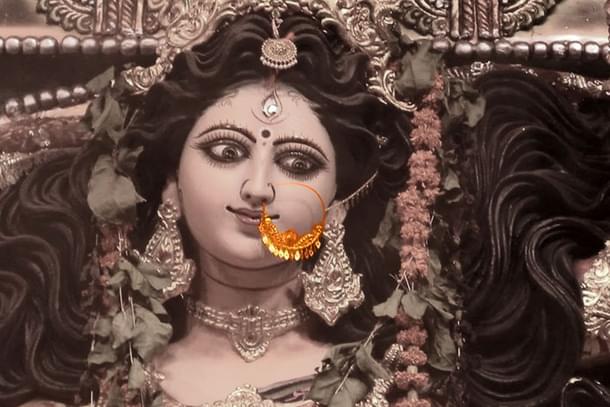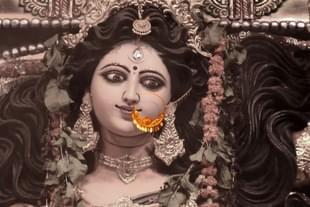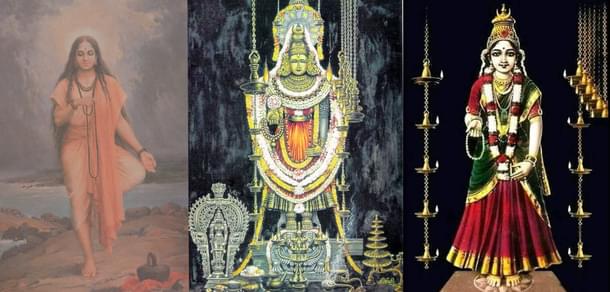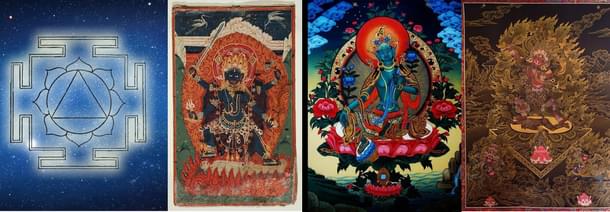Culture
Random Meditations Through Her 1,000 Names (XX): The Celestial Nose Ring
Aravindan Neelakandan
Jul 23, 2020, 06:10 PM | Updated Dec 16, 2024, 02:04 PM IST
Save & read from anywhere!
Bookmark stories for easy access on any device or the Swarajya app.


Read the previous report here.
“Tarakanti tiraskari nasabharanabhasura”
She is the one who wears a nose ring that dazzles brighter than the glittering stars.
These stars or group of star, as per traditional commentary on the Sri Lalita Sahasranama, refer to two goddesses — Mangala and Sukla. While Mangala refers to the red planet Mars, Sukla refers to Venus.
In the puranic tradition, both these planets are male deities. But Mangala Chandi is also considered as a goddess worshipped by Mangala. Thereby, Sukla would mean the goddess worshipped by Sukra.
But there is also a tradition, where both these morning stars are considered feminine. And this is the characteristic of a magnificent dharmic ocean like Sanatana Dharma. Or in the words of Niels Bohr, “the opposite of a very ordinary truth is falsehood but the opposite of a magnificent Truth is another one magnificent Truth.”
So whatever categorisation is made within Sanatana Dharma, the exact opposite of that categorisation will also be true somewhere — from tribal worship to Sthala Purana. Hence it is not surprising for a Hindu mind to read the commentary that the term Tara here may refer to two goddesses, Mangala and Sukla, in the context of celestial stars.
But her nose ring dazzles in such a way that it even defeats the shining stars of the night sky, and stands out.
This is a living local tradition in Kanyakumari. The goddess here is the meditating virgin goddess. Kumari Goddess is mentioned in the Taittiriya Aranyaka, probably belonging to fourth century BCE; Periplus of the Eryrthraean Sea (60 CE: author unknown) speaks of how those who dedicate their lives to the service of the divine come here and worship the goddess. So the goddess is not only ancient but also pan-Indic.
Local tradition has it that a patriarch of a Nadar family discovered a cobra gem or nagamani. It is a belief that a king cobra that has received a rain drop on Swati nakshatra develops this gem in its hood and when the snake turns 100 , the gem becomes precious and acquires healing and other magical qualities.
The Nadar patriarch handed over the nagamani to the king who in turn offered it to the goddess in the form of a nose ring. The family, which found the nagamani and handed it over to the king was called the Nagamani family. To this day, there are many in the Nadar community of Kanyakumari district who bear the name Nagamani.
This gem in the nose ring of the goddess was said to be quite bright. It is said that sometimes sailors mistook it for either star light or watch tower light and met with disaster in the rock filled seas of Kanyakumari.
It is also said that pirates got attracted by this rare gem and when they tried to loot it, often met with their doom. However, this nose ring was lost in time and the one that the goddess now wears is of recent origin.

That the nose ring of the goddess is brighter than the stars is thus a pervasive sacred imagery that is integral to Hindu mind. Whether it is the so-called folk or classical traditions of religion, it shows how organic and indivisibly interwoven the narratives of Hindu traditions are. This is an aspect that the colonial Indologists, binary-seeking Marxists and colonised Indian scholars could never comprehend.
Traditional commentary also states that the name can also refer to the Goddess Taraka or Tara. In puranic tradition, Tara is the wife of Brihaspati, the guru of the devas. She was abducted (in some accounts willingly) by Chandra or the moon-deva. In Ramayana, the name of the wife of Vali is Tara.
However, the Tara with whom the great mystic commentator associates this name is Tara the second of the 10 Maha Vidyas. The famous Shaktic scholar S Shankaranarayanan, who was under the dynamic influence of the great Shaktic Vedic seer of modern times Kapali Shastrigal, explains:
The worship of Tara is at least as old as the Vedas. ... The Sanskrit word Tara comes from the root tr.- to traverse. It is used to denote one who crosses, tarati, and makes others cross as well, tarayati. Tara or Taraka is the word in Sanskrit to denote a star as it traverses in space and acts as guiding light. It is also an appellation for the guiding light in the human eye, the pupil because of which the eye is justly called nayana or netra, that which leads. A boat is called tari, as it makes one cross the waters. The image of the ocean and the crossing of waters is largely employed in litanies of the Vedic seers. The Veda speaks of two oceans, superconscient and inconscient, one high above and the other down below. We can quote many Riks to show that the art of shipbuilding and navigation was not unknown to them. For instance, in the famous Rik, jatavedase addressed to Agni and later ascribed to the Goddess Durga in the Tantra, the Vedic Seer affirms that Agni carries him across all tribulations like a ship across the ocean naveva sindhum. And the Divine Mother, Aditi is accosted as the Divine Ship and the Seer prays: “May we ascend with quick propellers, faultless, intact without slits, a capable protector, spacious as Earth like heaven to which no hurt can come, a happy shelter and skillful carrier.”S Shankaranarayanan, The Ten Great Cosmic Powers, Dipti Publication, 1972, pp.23-5
But Tara is not just the goddess of travel, ferrying people safely across oceans of more than one kind. Tara has three forms: Ugra Tara, Nila Saraswati and Ekajata.

As Nila Saraswati, she is also the indestructible eternal word: nitya -vak and Akshara — the sound symbol of consciousness Aum. In fact, Pranava is considered the Taraka Mantra.
In a vision that in a mighty way combines the Taraka Mantra and the ferrying across the Manikarnika Ghat in Kashi, Sri Ramakrishna Paramahamsa saw Shiva whispering into the ears of the liberated souls cremated in Kashi the Taraka Mantra. Tradition says that Annapurna keeps the head of the departing soul in her lap and Shiva whispers the Taraka Mantra. Shankaranarayanan explains the other two forms of Tara thus:
Ugra Tara as the name indicates, is fierce and like Kali is mounted on a corpse. ... The Tantra says that She gathers all the ignorance of the triple worlds in Her bowl made of the human cranium and then destroys them in one sweep. ... Ekajata is the Goddess with a single matted hair signifying that all the scattered vibration of sound are being channelised in the act of creation.S Shankaranarayanan, p.27
Unfortunately, today in popular imagination Tara is mainly associated with Buddhism. In fact, she is considered as a Buddhist goddess whom non-Buddhist Hindus have borrowed.
It should be remembered that it was Tara who was the first woman-divinity to be recognised as having attained Buddhahood in Buddhism. In early Buddhism, the women could attain Arahathood but they could never become Bodhisattva.
The Jatakas also set a clear gender hierarchy. In Mahanaradakssapa-Jataka, a woman who is spiritually well-versed to teach even a king the intricacies of karma reveals to him her previous births. Because of the sin of coveting another man's wife, the male that the woman was in one of her previous births, had to be born in the realm of suffering (hell), then was born as a castrated goat, then a castrated ox and then a hermaphrodite.
Then in the next six births the person was born as a female. At the end of the Jataka, this woman was shown as the one reborn as Ananda, Buddha's chief disciple.
Dr Naomi Appleton, who studies early Indian religions (Vedic, Buddhist and Jain), points out in her study of Jataka stories in Theravada Buddhism:
When born as humans bodhisattas are able bodied men, explicitly not women, or those of both sexes, or of neither. ... Indeed the Buddhavamsa commentary on the verse about the eight conditions explains the need for the male state by a reference to the Buddha’s declaration that a woman cannot be a Buddha. ... The ability of humans to be reborn as either (or neither) sex is here found hand-in-hand with the idea that rebirth as a woman is bad. In the early sources rebirth as a woman is seen as bad because of the suffering inherent in a woman’s life, rather than because of the idea that women are less capable of spiritual development. Such ideas are clearly linked, however, for according to a simplistic view of kamma the reason for the suffering of a woman is her spiritual and ethical immaturity in a previous birth. This idea is present in Buddhist countries today: surveys conducted amongst Sri Lankan women ... showed that many Buddhist women believed their sex was decided by previous actions and that this explains the extra suffering endured by women, for example during childbirth. Kabilsingh records similar sentiments amongst Thai women, noting that this naturally benefits the monks, who receive many gifts from women hoping to make merit and attain a male rebirth.Naomi Appleton, Jataka Stories in Theravada Buddhism Narrating the Bodhisatta Path, Ashgate Publishing, 2010, p.94 & p.97
However, this aspect of Bodhisattva depiction and its subsequent effect on the women in Theravada societies are not given much importance she states:
However, the exclusion of women from buddhahood and the formal path to it in Theravada Buddhism has not attracted much attention from scholars, who generally view the restriction as unimportant given the priority of the arahat ideal (which is open to women) and the ability in any case of women to be reborn as men.Naomi Appleton, Jataka Stories in Theravada Buddhism Narrating the Bodhisatta Path, Ashgate Publishing, 2010, p.95
Now, that is quite easy to understand. Buddhism was constructed during the Victorian and larger parts of colonial period as an intermittent step in evangelism. A strong section of Indologists and evangelists saw Buddhism as "preparatio evangelica" — "as part of God's plan of salvation, more specifically, as a divinely ordained preparation for the Christian gospel”. (Philip C. Almond, The British discovery of Buddhism, Cambridge University Press, 1988, p.137)
Samuel Bael, the nineteenth century Buddhist scholar, in his detailed study of Buddhism stated that but for Buddhism people of India would be under tyranny of priesthood and that it had prepared Indians to receive ‘the higher truth’ that is Christianity.
Buddhism was having a civilising influence on Kanishka so that "Kanishka and his fierce tribes of Scyths were preparing a way of safety for the missionary to traverse through the mountain wilds of the East”.
The missionary he refers to is St Paul. Paul somehow could not come East despite this ‘Divine Plan’. (A Catena of Buddhist Scriptures, Trubner & Co,1871, p.8)
In 2001, this strategy was scaled up and employed in India. Rationalist Sanal Edamaruku exposed this strategy of Buddhism as "Preparation evangelica" when he wrote the following:
Official organizer of the Delhi meeting was the “All India Conference of Scheduled Castes and Tribes”, an umbrella organization of government employees with a membership of more than three millions. Secret wire puller and financier of the event, however, was the All India Christian Council (AICC), an outfit of the Evangelical Church, which comprises of all kinds of neo-protestant “born-again” and missionary organizations and is dominated by Baptists and Pentacostals. Special guests on the dias were AICC president Dr. Joseph D’Souza, vice-president John Dayal and general secretary Dr. K P Yohannan.... Their plan was to use the Buddhist conversions as a wedge to open the gates of India for the great millennium crusade. This plan could only succeed under the condition that the missionary finger in the pie remained unseen in India.Sanal Edamaruku, God longs for all Hindus!, Rationalist International Bulletin 83 (29 November 2001)
It is such a condition of forces against the Dharma exploiting and abusing the Dharma of Bhagwan Buddha against the Sanatana Dharma and Hindu Rashtra, that the Name reminds us of Tara’s Vedic roots.
As against the Theravada Buddhism forbidding women from becoming Buddha, the emergence of Tara as the first Buddhahood attained divine feminine in Buddhism has to be explained.
In the Sanatana Dharma, the ultimate divine is envisioned and experienced as feminine. Vedic Mantra drishtas, seers of divine-inspired sacred hymn — were themselves women.
Clearly, one has to accept the influence and path correction effected by Vedic Dharma on Buddhism.
In this context, it may be pertinent to point out what Prof Miranda Shaw, Buddhist scholar, in her exhaustive study of the Buddhist goddesses of India points out:
... the cosmology of early Buddhist literature and art cannot be understood without reference to India’s proto-historical iconography and Vedic and Upanishadic thought.... For example, Vasudhara, the golden, grain-bearing goddess of abundance, has as her main prototype Prthivi, mother earth. Both Vasudhara and Tara inherited traits from Lakshmi, the lotus lady. The original conception of Marichi was modeled on that of Ushas, the Vedic goddess of the dawn. When Marichi was recast as a warrior goddess, her martial persona was patterned on that of Durga in her demon-slaying mode.Miranda Eberle Shaw, Buddhist Goddesses of India, Princeton University Press, 2006, pp.449-50
Buddhists did not appropriate Tara. On the other hand, the goddess made Buddha Dharma a whole and had her own evolution through Buddhism.
In countries like China and Japan, the strong presence of Tara as feminine Buddhist principle at its highest allowed uninterrupted evolution of the adoration and realisation of the divine feminine. This is Samanvaya in action — Vedic principle of organic growth of sacred-diversity. As Buddhist scholar Prof Lokesh Chandra states, theo-diveristy and bio-diversity go hand in hand.
Yet for colonised Indians, Buddhism was a reformist or worse anti-Vedic movement.
They associate anything good in Indian society and culture with Buddhism and everything deemed wrong and unjust with Vedic Dharma.
In fact, this has become the axiom and framework for doing history and social science in our institutions.
When we mediate upon the Name Tarakanti tiraskari nasabharanabhasura let us not forget the contribution that Vedic Dharma made and the course correction that Sanatana Dharma effected on the Dharma of Buddha — removing a chief deficiency.
Let us pray that she sheds path-correcting light through the darkness imposed by the vestiges of colonialism and its derived vested ideological interests that breed hatred through ignorance.
Let her lead us from hatred to love through wisdom and destruction of ignorance.
Aravindan is a contributing editor at Swarajya.





